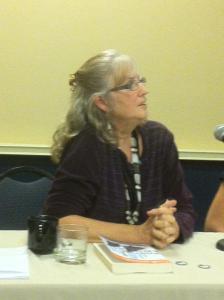By Jane Palmer
Three science communicators from government agencies shared savvy strategies for communicating science research to the public and policy makers on Saturday afternoon at ScienceWriters2013 in Gainesville, FL. Although they were talking about their experiences promoting federally-funded research, their tips proved valuable to anyone — public information officers, scientists, or educators — involved in science outreach and communication.
“To be informative you have to be engaging and entertaining — at least some of the time,” said Charles Rousseaux, senior science writer at the Department of Energy (DOE). The DOE predominantly uses press releases to publicize its basic science research to the public, whereas Cecile Gonzalez, science writer and editor at the National Science Foundation (NSF), discussed how the NSF is building collaborations with other media outlets such as IEEE Spectrum Radio and LiveScience.com. She profiled the win-win collaboration between the NSF and NBC Learn that yielded the science of sport series and coverage of last year’s summer Olympics; the NSF provided the science and engineering expertise for the series under the agreement it be shown for free at schools.
“We are really trying to reach new audiences,” Gonzalez said. “We have a lot of traffic on our websites but that is still not where most of the public get their news.”
Catherine Puckett, acting chief of public affairs at the United States Geological Survey (USGS), estimated half of her day is spent interacting with the media as a means to getting USGS research to the public ear. She sees USGS communications as “giving voice to things that don’t have a voice — the plants, the animals, the ecosystems.” The USGS also uses social media to spread its message, boasting more than 300,000 followers of its twitter account.Reaching policy makers was an entirely different animal altogether agreed the speakers. “You assume that the staffer has 30 seconds and message the science appropriately,” Rousseaux said. In this context relationships are critical and the DOE will sometimes take scientists directly to Capitol Hill to meet legislators and their staffers, he said.
The NSF uses the same tactic emphasizing the societal and economic benefits of NSF-funded science on their visits and also sometimes taking along graduate students. “They are often very interested in how we are preparing our future workforce,” Gonzalez said.
The USGS holds a series of congressional briefings every year on high priority subjects and conducts a large annual congressional field trip to venues such as the Everglades or the Chesapeake Bay that face unique environmental challenges. The USGS and other federal institutes do science that is pertinent to societal issues and it is critical to communicate that science to both policy makers and the public, Puckett said.
Gonzalez goes one step further saying that the NSF, as a taxpayer-funded agency, has an obligation to report to the public on how their taxes have been spent. “Putting it on our own website isn’t really sufficient,” Gonzalez said. “We really want to let more people know what kind of great things are being discovered and invented because of their investment.”


